
Shinkansen is known as "bullet train".
System length of Shinkansen is 3,273km. Originally, Tokaido Shinkansen started operation from Tokyo to Shin-Osaka in 1964. Currently, there are nine Shinkansen lines in total in Japan. Originally, Tokaido Shinkansen started operation in 1964... |
|
The New Luggage Policy on the Tokaido, the Sanyo and the Kyushu Shinkansen Lines becomes effective on May 20, 2020. |

Tokaido Shinkansen is the origin of the Shinkansen lines. It is the most popular and the most crowded Shinkansen. Approximately 445 thousand passengers take Tokaido Shinkansen a day. Tokaido Shinkansen runs...
|
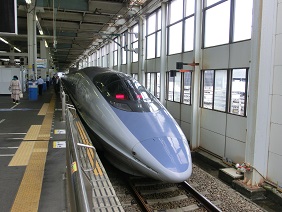
Sanyo Shinkansen runs through Kobe, Himeji, Okayama, Hiroshima, Shin-Yamaguchi, Kokura in Kita Kyushu and Hakata in Fukuoka from Shin-Osaka. There are a total 19 stations including Shin-Osaka and Hakata Stations.
|

Kyushu Shinkansen runs from Hakata Station to Kagoshima-Chuo Station through Kumamoto. Kyushu Shinkansen connects major cities in Kyushu and middle size class cities in Fukuoka, Kumamoto and Kagoshima prefectures...
|

Tohoku Shinkansen is from Tokyo Station to Shin-Aomori station, and this is the main artery between Kanto and Tohoku.
Tohoku Shinkansen is the second busiest Shinkansen line following the Tokaido Shinkansen. Approximate...
|

Hokkaido Shinkansen is the newest Shinkansen. It opened between Shin-Aomori and Shin-Hakodate-Hokuto on March 26th, 2016.
Eleven "Hayabusa's" and two "Hayate's" run daily in either direction. The operation sections of...
|

Yamagata Shinkansen is a branch line of the Tohoku Shinkansen.
Yamagata Shinkansen line runs from Fukushima to Shinjyo through Yamagata.
Yamagata Shinkansen started operation in 1992. Different from...
|
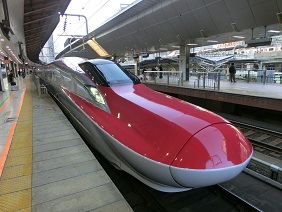
Akita Shinkansen is also a branch line of the Tohoku Shinkansen. Akita Shinkansen runs from Morioka to Akita.
Akita Shinkansen started operation in 1997. Akita Shinkansen run on existing lines with enlarged...
|

Joyetsu Shinkansen is also a branch line of the Tohoku Shinkansen. Jyoetsu Shinkansen line is defined between Ohmiya and Niigata, but all the Jyoetsu Shikansen trains run from Tokyo Station. Jyoetsu Shinkansen...
|

Hokurikku Shinkansen line is defined from Takasaki to Kanazawa. Hokuriku Shinkansen between Takasaki and Jyoetsu-Myoko is owned by JR East and the rest of line is owned by JR West. All Hokuriku Shinkansen...
|
|
"Back to the Top of Shinkansen"
"Back to the Top Japan Railways Lines"
"Back to the Top of Riding Trains"

General Information of Shinkansen
Shinkansen is known as "bullet train". |
| JR Hokkaido: | Hokkaido Shinkansen | Shin Aomori - Shin Hakodate Hokuto | 148.8km |
| JR East |
Tohoku Shinkansen Jyoetsu Shinkansen Hokuriku Shinkansen Yamagata Shinkansen Akita Shinkansen |
Tokyo - Shin Aomori Ohiya - Niigata Takasaki - Myuko Jyoetsu Fukushima - Shinjyo Morioka - Akita |
713.7km 303.6km 176.9km 148.6km 127.3km |
| JR Central: | Tokaido Shinkansen | Tokyo - Shin Osaka | 552.6km |
| JR West |
Hokuriku Shinkansen Sanyo Shinkansen |
Myoko Jyoetsu - Kanazawa Shin Osaka - Hakata |
168.6 km 644.0km |
| JR Kyushu | Kyushu Shinkansen | Hakata - Kagoshima Chuo |
288.9km
|
|
System length of Shinkansen is 3,273km. The details of each Shinkansen line will be explained later. 
Originally, Tokaido Shinkansen started operation from Tokyo to Shin-Osaka in 1964. It was extended to Hakata in 1975, as Sanyo Shinkansen. In 1982, Tohoku Shinkansen opened between Omiya and Morioka. The entire line between Tokyo and Shin-Aomori was completed in 2010. Joetsu Shinkansen started operation in 1982. Yamagata and Akita Shinkansen opened in 1992 and 1997, respectively. Recently, Kyushu Shinkansen completed in 2010 and Hokkaido Shinkansen started operation in 2016.
The key features of Shinkansen are grade separation, all train control system (ATC) and standard gage (1,435mm) track, while all other JR lines have 1,067mm of narrow gage. The maximum speed was 210km/hr. (131 MPH) when Tokaido Shinkansen opened. It held the world's fastest record until 1995, when TGV in France started operation. The maximum speed increased to 220km/hr. (138 MPH) in 1987, 270 km/hr. (169 MPH) in 1992. Then, 300km /hr. (188 MPH) of maximum speed was achieved in 1997. JR East started to run "Hayabusa" at 320km/hr. in 2013 between Utsunomiya and Morioka. However, Yamagata Shinkansen and Akita Shinkansen trains run on conventional lines with crossings. As a result, Yamagata Shinkansen and Akita Shinkansen trains only run at 130km/hr. (81 MPH). |
|
"Back to the Top of Shinkansen"
"Back to the Top Japan Railways Lines"
"Back to the Top of Riding Trains"

Tokaido Shinkansen
Tokaido Shinkansen is the origin of the Shinkansen lines. It is the most popular and the most crowded Shinkansen. Approximately 445 thousand passengers take the Tokaido Shinkansen a day. Tokaido Shinkansen runs from Tokyo to Shin-Osaka. There are 15 stations between Tokyo and Shin-Osaka. On the Tokaido Shinkansen line, three different types of Super Limited Express trains run. The fastest bullet train is named "Nozomi" meaning "hope" in Japanese. "Nozomi" stops at Shinagawa, Shin-Yokohama, Nagoya and Kyoto after departing from Tokyo. The second one is "Hikari". The third, "Kodama" stops at every station. "Nozomi" travels between Tokyo and Shin-Osaka in 2 hours 30 minutes to 33 minutes. "Hikari" takes 2 hours 53 minutes and "Kodama" takes 4 hours 4 minutes between the stations. 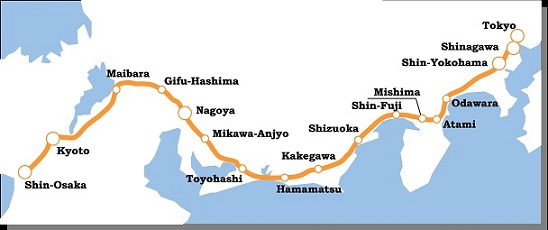
Tokaido Shinkansen runs 15 trains an hour during peak times. Ten trains are "Nozomi", two trains are "Hikari" and three trains are "Kodama". During the daytime, five "Nozomi's" run every hour. Three of them run into Sanyo Shinkansen to Hakata or Hiroshima. Also, two "Hikari's" run between Tokyo and Okayama or Shin-Osaka. Two "Kodama's" run between Tokyo and Shin-Osaka or Nagoya every hour. |
|
Tokaido Shinkansen N700 series

|
Tokaido Shinkansen 700 series
 |
|
Tokaido Shinkansen and Sanyo Shinkansen are integrally operated by JR Central and JR West. Both JR companies use the same train types for all the train sets which run through these two Shinkansen lines.
The N700 series train models (The upper left picture) are the newest trains and are used in serving all kinds of Shinkansen trains. The N700 series trains have the capability to run at 300km/hr. (188 MPH). However, as Tokaido Shinkansen has old track specifications with tight curb radius, the maximum speed is limited to 285 km/hr. (178 MPH) on the Tokaido Shinkansen Line. The 700 series train models also consists of 16 cars and are used for "Hikari" and "Kodama". The maximum speed of the 700 series is 285 km/hr. (178 MPH).
For both the N700 and the 700 series trains, three cars in the middle, from the car numbers 8 to 10, are "Green Cars", while all others are coach cars.
"Green Cars" have 2 + 2 seat layout (see the below left pictures). Gorgeous seats with foot rests are installed. |
|
"Green Car" of N700 series train

|
Coach class car of N700 series train
 |
|
Coach cars are also equipped with reclining seats. The seat pitch is 1,040 mm. This allows you to stretch your legs comfortably. New luggage policy becomes effective on May 20, 2020: The New Luggage Policy. Tokaido Shinkansen runs through megalopolis areas between Tokyo and Osaka. You will only see buildings and houses. On the other hand, you can also see beautiful scenery. Mt. Fuji is a typical example. If it is fine and clear, especially in winter, you can see Mt. Fuji between Shin-Yokohama and Odawara. Especially, after passing Mishima Station, Mt. Fuji is shown up on your right when you travel from Tokyo to Nagoya or Shin-Osaka. |
|
Mt. Fuji at twilight

|
Mt. Fuji from "Nozomi"
 |
|
Lake Hamana between Hamamatsu and Toyohashi

|
Mt. Ibuki between Gifu-Hashima and Maibara
 |
|
The next view point is Lake Hamana. This lake is located between Hamamatsu and Toyohashi. After passing Nagoya, Mt. Ibuki is on your right. At the foot of Mt. Ibuki, it was the sight of the biggest internal war between TOKUGAWA Ieyasu and ISHIDA Mitsunari in 1600. This war divided the entire country into two parties and it is said that a total 400 thousand soldiers were involved. Along Tokaido-Shinkansen, there are very many historical spots. Soon after passing through Mt. Ibuki, Lake Biwa is on your right. However, Tokaido Shinkansen runs a bit away from Lake Biwa so you can only get a glimpse. In Kyoto, you can see Kyoto Tower, a candle shaped tower, on your right and the five-storied pagoda of Touji Temple on your left. Then, Tokaido Shinkansen trains will arrive at Shin-Osaka Station. Please enjoy your trip on Tokaido Shinkansen! |
|
"Back to the Top of Shinkansen"
"Back to the Top Japan Railways Lines"
"Back to the Top of Riding Trains"

Sanyo Shinkansen
Sanyo Shinkansen runs through Kobe, Himeji, Okayama, Hiroshima, Shin-Yamaguchi, Kokura in Kita Kyushu and Hakata in Fukuoka from Shin-Osaka. There are a total 19 stations including Shin-Osaka and Hakata Stations. Sanyo Shinkansen is the second Shinkansen line. It opened from Shin-Osaka to Okayama in 1972, as the first step. Later, the line was extended to Hakata Station in 1975. Sanyo Shinkansen is operated by JR West between Shin-Osaka and Hakata. At Shin-Osaka Station, Sanyo Shinkansen is connected to the Tokaido Shinkansen. Also at Hakata Station, Sanyo Shinkansen is connected to Kyushu Shinkansen. So, Tokaido Shinkansen, Sanyo Shinkansen and Kyushu Shinkansen are integrally operated by JR Central, JR West and JR Kyushu. 
On the Sanyo Shinkansen line, "Nozomi", "Hikari", "Kodama", "Mizuho" and "Sakura" operate. "Mizuho" and "Sakura" are train names for Kyushu Shinkansen. Unfortunately, there is no unique train name for Sanyo Shinkansen. All "Mizuho" and "Sakura" run through the Sanyo and Kyushu Shinkansen. "Mizuho" is the fastest type Shinkansen, similar to "Nozomi" with the most limited stops. "Sakura" is the equivalent level to "Hikari" In day time, "Nozomi" runs three times per hour. All of them are from Tokyo. Two of them run to Hakata and the other one runs to Hiroshima. One "Hikari" from Tokyo runs to Okayama. This "Hikari" stops at every station on the Sanyo Shinkansen line. Also, "Sakura" runs once every hour. Six "Mizuho's" run daily, mainly in the morning and evening peak times. "Kodama" also runs once every hour from Okayama to Hakata during the day. |
|
Hikari Rail Star700 series
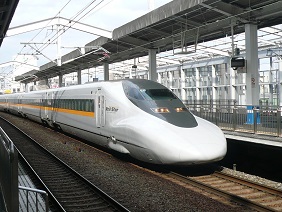
|
Sanyo Shinkansen 500 series
 |
|
All "Nozomi's" and "Hikari's" which run through the Tokaido and Sanyo Shinkansens use the same train types as Tokaido Shinkansen. It means the N700 series and the 700 series of train models are used and they consist of 16 cars. The N700 series trains run at 300 km/h (188 MPH) on Sanyo Shinkansen.
On the other hand, "Hikari Railstar's" and "Kodama's", which run inside Sanyo Shinkansen, use different train types from that of the Tokaido Shinkansen. These trains have 8 cars without any "Green Cars". Instead, there is a 2 + 2 seat layout of the cars for passengers with seat reservations.. |
|
Coach Car of "Hikari Railstar"
 |
|
"Mizuho" and "Sakura" use the N700 series trains, but these N700 series trains consist of 8 cars. Also, these trains have 2 + 2 seat layouts on coach cars. New luggage policy becomes effective on May 20, 2020: The New Luggage Policy. Sanyo Shinkansen runs along the Seto Inland Sea between Chugoku and Shikoku. However, Sanyo Shinkansen runs a couple kilometers away from the sea. Actually, Sanyo Shinkansen runs through many tunnels. Between tunnels, you can see rivers in mountains and also rural landscape. As far as I know, the only spot you can see the Seto Inland Sea is near Tokuyama Station. |
|
The Yoshii River between Himeji and Okayama
 |
View of the Seto Inland Sea at Tokuyama
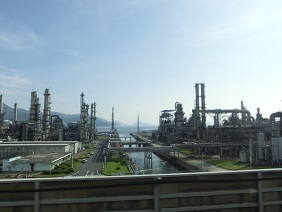 |
|
After passing Shin-Shimonoseki Station, Sanyo Shinkansen runs through the New Kanmon Channel Tunnel while crossing the Kanmon Channel between the main island of Japan and the Kyushu Island. After passing though Kanmon Channel, Sanyo Shinkansen runs in Kyushu Island, until reaching Hakata terminal. |
|
"Back to the Top of Shinkansen"
"Back to the Top Japan Railways Lines"
"Back to the Top of Riding Trains"

Kyushu Shinkansen
Kyushu Shinkansen runs from Hakata Station to Kagoshima-Chuo Station through Kumamoto. Kyushu Shinkansen connects major cities in Kyushu and middle size class cities in Fukuoka, Kumamoto and Kagoshima prefectures; for example, Kurume, Ohmuta and Yatsushiro. | ||

|
Kyushu Shinkansen started operations from Shin-Yatsushiro and Kagoshima-Chuo in 2004. The section between Hakata and Shin-Yatsushiro opened on March 12, 2011 and the Shinkansen lines were connected from Tokyo to Kagoshima-Chuo. This was the day after the Great East Japan Earthquake struck Tohoku and the North Kanto Area.
On Kyushu Shinkansen, "Mizuho", "Sakura" and "Tsubame" runs. "Tsubame" stops at every station, and "Sakura" is the intermediate train between "Mizuho" and "Tsubame". The maximum speed on Kyushu Shinkansen is limited to 260 km/hr. (163 MPH). "Mizuho" travel time is just one hour and 17 minutes between Hakata and Kagoshima-Chuo. |
|
|
The train models on Kyushu Shinkansen are the N700 series and the 800 series. The N700 series is used for all trains which run between Sanyo Shinkansen and Kyushu Shinkansen. The 800 series is used for the trains which run within Kyushu Shinkansen, mainly for "Tsubame". |
||
|
Kyushu Shinkansen N700 series

|
Kyushu Shinkansen 800 series "Tsubame"
 |
|
The N700 series trains for "Mizuho" and "Sakura" are different from that of the N700 series used on Tokaido Shinkansen. The N700 series trains for "Mizuho" and "Sakura" consist of 8 cars. On the car number 6, half of the car is designated as a "Green Car". The car numbers 1 to 3 are for passengers without seat reservations, while all other cars are for passengers with seat reservations. The "Green Cars" and the coach cars for passengers with seat reservations have 2 + 2 seat layout, while the coach cars have 2 + 3 seat layout. |
|
"Green Car" on N700 "Sakura"

|
N700 Coach Class car with seat reservation 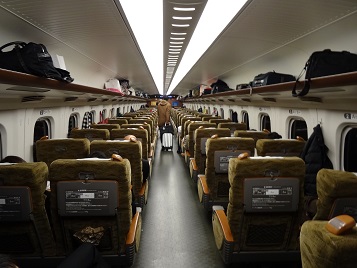
|
|
The 800 series Car number 1

|
The 800 series Car number 2 
|
|
The 800 series trains also consist of 8 cars, but these trains do not have a "Green Car". All cars are for coach class passengers and have 2 + 2 seat layout. The 800 series trains have three different interior designs. Two of them are shown in the above pictures. New luggage policy becomes effective on May 20, 2020: The New Luggage Policy. Although there are a lot of scenic areas in Kyushu, unfortunately the landscape from Kyushu Shinkansen is not especially good. You can enjoy sightseeing and see beautiful scenery by traveling rapidly on Kyushu Shinkansen. |
|
"Back to the Top of Shinkansen"
"Back to the Top Japan Railways Lines"
"Back to the Top of Riding Trains"

Tohoku Shinkansen
Tohoku Shinkansen runs from Tokyo Station to Shin-Aomori station, and is the main artery between Kanto and Tohoku. Tohoku Shinkansen is the second busiest Shinkansen line following Tokaido Shinkansen. Approximately 205 thousand passengers take the Tohoku Shinkansen daily. Tohoku Shinkansen is the third Shinkansen line, which started operations in 1982. At first, Tohoku Shinkansen opened between Ohmiya and Morioka. Then, it was extended to Ueno in 1985, and to Tokyo in 1991. | ||
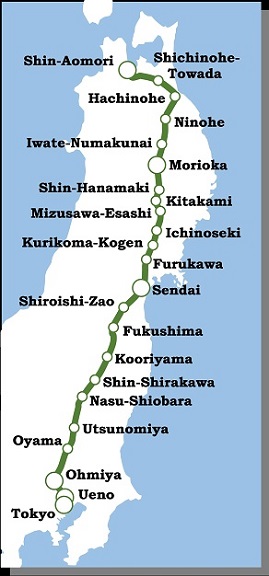
|
Tohoku Shinkansen was also extended north. In 2002, the section between Morioka and Hachinohe opened. It finally reached Shin-Aomori in 2010. It took 27 years to complete the entire Tohoku Shinkansen line. After the Hokkaido Shinkansen started operations from Shin-Aomori to Shin-Hakodate-Hokuto in 2016, the Shinkansen system now connects Hokkaido Island, the Main Island of Japan Honshu, and Kyushu Island. At Tokyo Station, rails of Tokaido Shinkansen and Tohoku Shinkansen are not connected with each other. Because no train runs through these two Shinkansen lines, you have to change Shinkansen trains at Tokyo Station. Tohoku Shinkansen has several branch Shinkansen lines. These are the Jyoetsu and Hokuriku Shinkansens at Ohmiya, Yamagata Shinkansen at Fukushima and Akita Shinkansen at Morioka. Including Hokkaido Shinkansen at Shin-Aomori, Tohoku Shinkansen is integrally operated with these branch Shinkansen lines. |
|
|
On the Tohoku Shinkansen line, "Hayabusa", "Hayate", "Yamabiko" and "Nasuno" operate. Some "Hayabusa's" connect with "Komachi's", which are Akita Shinkansen trains, between Tokyo and Morioka. The maximum speed of Hayabusa is 320 km/hr. (200 MPH) between Utsunomiya and Morioka. It runs at 275 km/hr. (176 MPH) between Ohmiya and Utsunomiya and runs at 260 km/hr. (163 MPH) between Morioka and Shin-Aomori. The maximum speed between Tokyo and Ohmiya is limited to 110 km/hr. (69 MPH). |
||
|
E5 series for "Hayabusa" and "Hayate"

|
E2 series for all trains except "Hayabusa"
 |
|
"Hayate" is the next fastest train and goes from Tokyo to Morioka, and from Morioka and Shin-Aomori to Shin-Hakodate-Hokuto.
The maximum speed of the "Hayate" is 275 km/hr. (176 MPH).
"Yamabiko" runs from Tokyo to Sendai and to Morioka.
Many "Yamabiko"s connect with "Tsubasa"s, which run between Tokyo and Fukushima through Yamagata Shinkansen. The E2 series and the E5 series trains are used for "Yamabiko" and "Nasuno". "Yamabiko" and "Nasuno" have cars for passengers without seat reservations. |
|
Connection of E5 series and E6 series

|
Connection of E5 series and E2 series
 |
|
The E5 series and the E2 series trains consist of 10 cars.
Car number 10 of the E5 series is the "Gran Class" car. The "Gran Class" car has 1 + 2 seat layout with very luxury seats. Car attendants and free drink service is available. |
|
Gran Class

|
Coach car of E5 series train model
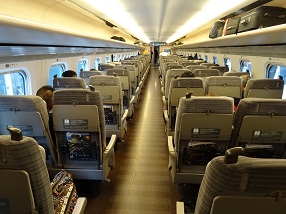 |
|
The car design of the E5 and E2 trains models are quite similar to that of N700 and 700 series trains models used on Tokaido Shinkansen. Please refer to the session of Tokaido Shinkansen for the detailed explanation: Tohoku Shinkansen runs along the Ou Mountains, which are located in the middle of Tohoku from south to north. The scenery and view from the Tohoku Shinkansen is spectacular on fine and clear days.
After departing Tokyo Station, Tohoku Shinkansen trains go underground and pass Ueno Station. After coming back to above ground, Tohoku Shinkansen runs through built-up areas until Ohmiya. In order to avoid noise pollution problems, the Shinkansen runs at 110 km/hr. (69 MPH) which is the maximum speed in this section. |
|
Mt. Fuji between Ueno and Ohmiya
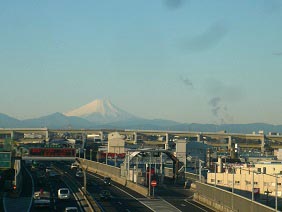
|
Mt. Nantai
 |
|
Mt. Nasu from Shin-Shirakawa St.
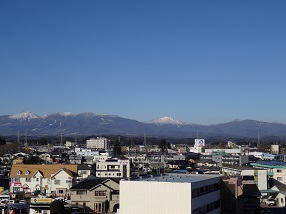
|
The view of Ou Montains
 |
|
After passing Ohmiya, Tohoku Shinkansen starts to run along the Ou Mountains. After passing Utsunomiya Station, you can see Mt. Nasu. While viewing Mt. Nasu, Tohoku Shinkansen trains pass Shin-Shirakawa Station. Then, you will enter the Tohoku area. Wide rice fields and the view of mountains are typical scenery in Tohoku. Following Mt. Nasu, Mt. Adatara, Mr. Azuma near Fukushima, and Mt. Zao near Shiroishi-Zao come into view. When Tohoku Shinkansen trains approach Morioka, you can see Mt. Iwate on your left. |
|
Mt. Zao near Shiroishi-Zao St.

|
Mt. Iwate near Morioka St.
 |
|
These mountains views are the special features of Tohoku Shinkansen. |
|
"Back to the Top of Shinkansen"
"Back to the Top Japan Railways Lines"
"Back to the Top of Riding Trains"

Hokkaido Shinkansen
Hokkaido Shinkansen is the newest Shinkansen. It opened between Shin-Aomori and Shin-Hakodate-Hokuto on March 26th, 2016. Eleven "Hayabusa's" and two "Hayates" run daily in each direction. The operation sections of "Hayabusa's" are between Tokyo and Shin-Hakodate-Hokuto, and between Sendai and Shin-Hakodate-Hokuto. "Hayato's" run between Morioka and Shin-Hakodate-Hokuto and between Shin-Aomori and Shin-Hakodate-Hokuto. | ||
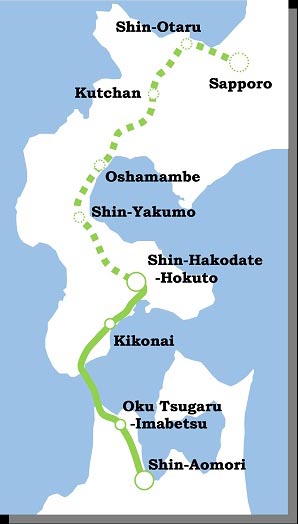
|
Hokkaido Shinkansen connects the main Island of Japan and the Hokkaido Island through Seikan Tunnel under Tsugaru Channel.
The Seikan Tunnel has been used for existing Japan Railways line. The track gage of the existing line is 1,067mm and that of Shinkansen is 1,435mm. So, in this section, three rails are placed for both freight trains and for Hokkaido Shinkansen trains. For safety reasons, the maximum speed of Hokkaido Shinkansen inside Seikan Tunnel is limited to 140 km/hr. (88 MPH). Plans are underway to extend Hokkaido Shinkansen to Sapporo. It is not clear, as of now, when this extension will be completed. |
|
|
Hokkaido Shinkansen and Tohoku Shinkansen are integrally operated by JR Hokkaido and JR East. The E5 train models of JR East and the H5 train models of JR Hokkaido are used for all Hokkaido Shinkansen trains. |
||
|
H5 series Train Model

|
The emblem of JR Hokkaido
 |
|
The H5 train models have purple line designs, while the E5 train models have pink line designs. The H5 train models have also the emblem of JR Hokkaido. |
|
"Back to the Top of Shinkansen"
"Back to the Top Japan Railways Lines"
"Back to the Top of Riding Trains"

Yamagata Shinkansen & Akita Shinkansen
Yamagata Shinkansen and Akita Shinkansen are branch lines of Tohoku Shinkansen. The Yamagata Shinkansen started operation in 1992 and the Akita Shinkansen in 1997. Different from other Shinkansen lines, Yamagata Shinkansen and Akita Shinkansen run on existing lines with enlarged track gage from 1,067 mm to 1,435 mm. It means the track specifications of these two Shinkansen lines are different from other Shinkansen lines. Also, the safety systems are different from other Shinkansen lines. Therefore, the maximum speed of Yamagata Shinkansen and Akita Shinkansen is limited at 130 km /hr. This is the same as other existing JR (Japan Railways) lines. | ||
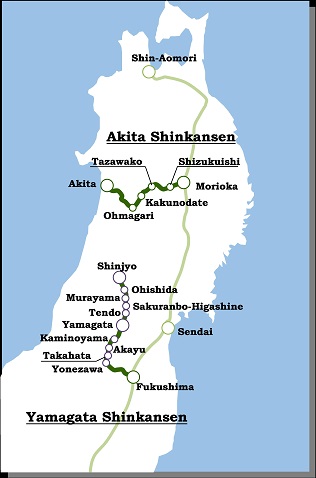
|
On the Yamagata Shinkansen line, "Tsubasa" runs from Tokyo to Yamagata and Shinjyo.
All "Tsubasa" trains are connected to "Yamabiko" between Tokyo and Fukushima. The stations which "Tsubasa" stops at on Yamagata Shinkansen are listed on the left map. "Tsubasa" stops at all the stations between Yamagata and Shinjyo, but basically "Tsubasa"s bound for Shinjyo do not stop at Takahata, and some "Tsubasa" stops only at Yonezawa between Fukushima and Yamagata. It is best to check closely the timetable. In the case of Akita Shinkasen, "Komachi" runs from Tokyo to Akita. "Komachi" is connected to "Hayabusa" between Tokyo and Morioka. Among the stations listed on the left map, only four "Komachi"s stop at Shizukuishi daily. |
|
|
The E3 train models are used for "Tsubasa" on Yamagata Shinkansen. The E6 train models are used for "Akita" on Akita Shinkansen. |
||
|
The E3 train models for "Tsubasa"

|
The E6 train models for "Komachi"
 |
|
Both the E3 and E6 train models consist of 7 cars with cars numbers 11 to 17. Car number 11 is the "Green Car" and the others are coach cars. All the cars of the E3 and the E6 have 2 + 2 seat layout. |
|
The Coach Car of the E3 train models

|
The Coach Car of the E6 train models
 |
|
All the seats of "Komachi's" run from Tokyo to Akita require reservations. As mentioned above, Yamagata Shinkansen and Akita Shinkansen run on the existing lines, while other Shinkansen lines were newly built with grade separation tracks, for example with elevated track or through tunnels.
As these two Shinkansen lines run through the Ou mountains, the scenery from these two Shinkansens is very beautiful. |
|
Village Scenery along Yamagata Shinkansen

|
Cherry Blossoms along Yamagata Shinkansen
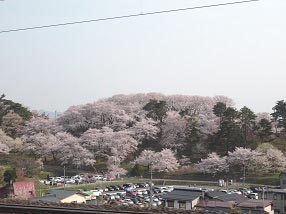 |
|
Mt. Iwate from Akita Shinkansen

|
Mountain View along Akita Shinkansen
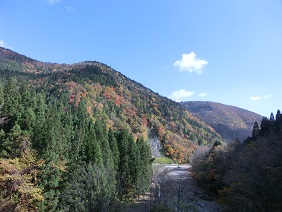 |
|
Such lovely scenery from these two Shinkansen is typical and original landscape of Japan. Along these Shinkansen lines, there are very many good and well-known hot springs and historical towns, such as Yonezawa and Kakunodate. Please explore Japan by Shinkansen! |
|
"Back to the Top of Shinkansen"
"Back to the Top Japan Railways Lines"
"Back to the Top of Riding Trains"

Jyoetsu Shinkansen & Hokuriku Shinkansen
Joyetsu Shinkansen and Hokuriku Shinkansen are also branch lines of Tohoku Shinkansen. Jyoetsu Shinkansen line is defined between Ohmiya and Niigata, but all Jyoetsu Shikansen trains run from Tokyo Station. Jyoetsu Shinkansen has the branch line from Echigo-Yuzawa to Gala-Yuzawa. As Gala-Yuzawa Station is the terminal for a ski area, trains run only during ski seasons.
The Hokurikku Shinkansen line is defined from Takasaki to Kanazawa. Hokuriku Shinkansen between Takasaki and Jyoetsu-Myoko is owned by JR East while the rest of the line is owned by JR West. Hokuriku Shinkansen is expected to extend to Tsuruga through Fukui by 2023.
Joetsu Shinkansen started operation in 1982 and Hokuruki Shinkansen in 2015. 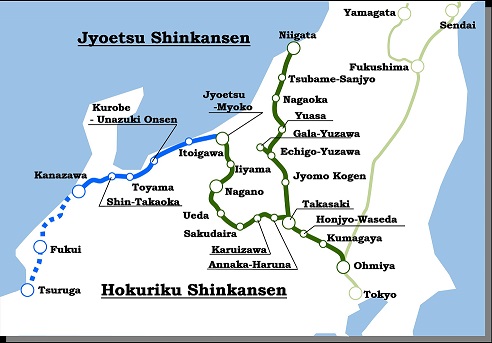
On Jyoetsu Shinkansen, "Max Toki", "Toki","Max Tanigawa" and "Tanigawa" run. "Max Toki" and "Toki" run between Tokyo and Niigata. "Max Toki" and "Toki" have limited stops. The stations, at which "Max Toki" and "Toki" stop, depend on each train. So, it is necessary to check the timetable closely when you travel to a station between Tokyo and Niigata. "Max Tanigawa" and "Tanigawa" run between Tokyo and Ehigo-Yuzawa with every stop. In winter, some "Max Tanigawa" and "Tanigawa" run to Gala-Yuzawa. The maximum speed on Jyoetsu Shinkansen is 240 km/hr. The E4 and the E2 train models are used for Joetsu Shinkansen trains. The E4 train models are double deck trains. Trains which use the E4 train models have the nickname of "Max", for example "Max Toki" and "Max Tanigawa". |
|
The E4 train models

|
The E2 train models
 |
|
The E4 train models consist of 8 cars. The cars numbered from 1 to 3 are for passengers without seat reservations and these cars have 3 + 3 seat layout. Unfortunately, these seats are not reclining seats.
The E2 train models for Jyoetsu Shinkansen consist of 10 cars. Car number 9 is the "Green Car". On Hokuriku Shinkansen, "Kagayaki", "Hakutaka", "Asama" and "Tsurugi" operate. "Kagayaki" is the fastest train type between Tokyo and Kanazawa with most limited stops only at Ohmiya, Nagano and Toyama. Some "Kagayaki"s also stop at Ueno. "Hakutaka" runs also between Tokyo and Kanazawa. "Hakutaka" stops at all stations between Nagano and Kanazawa. "Asama" runs between Tokyo and Nagano. "Tsurugi" runs between Toyama and Kanazawa. The E7 and the W7 train models and the E2 train models are used for Hokuriku Shinkansen. The E2 train models are only used for "Asama". The E7 and the W7 are used for all train types. The E7 and the W7 train models have the same design, but the E7 train models are owned by JR East while the W7 train models are owned by JR West. Both the E7 and the W7 train models consist of 12 cars. |
|
The E7 train models

|
The Coarch Car of the E7 Train Models
 |
|
Car number 12 is the "Gran Class" car with 1 + 2 seat layout. Car number 11 is the "Green Car" with 2 + 2 seat layout. Other cars are coach cars with 2 + 3 seat layout. Cars numbered 1 to 5 are for passengers without seat reservations. All seats of the E7 and the W7 train models have electric outlets for charging smart phones, tablets and PCs. The E2 train models which run on Hokuriku Shinkansen consist of 8 cars. Car number 7 is the "Green Car", and cars numbered 1 to 4 are for passengers without seat reservations. Jyoetsu Shinkansen runs across the Japan Main Island through the Mikuni Mountain Range. On the Pacific Ocean side, the Kanto plains are widely spread and mountains surrounding Kanto plains can be seen from Jyoetsu Shinkansen. The mountains are Mt. Kobushi, Mt. Myogi, Mt. Haruna and Mt. Akagi. Mt. Asama also can be seen from the Takasaki area. After passing Jyomo-Kogen, the Jyoetsu Shinkansen trains enter Dai-Shimizu Tunnel across the Mikuni Mountain Range. The length of Dai-Shimizu tunnel is 22,221m. This was the world longest tunnel when Jyoetsu Shinkansen opened in 1982. Dai-Shimizu Tunnel divides the Pacific Ocean side and the Japan Sea side. In winter, the Pacific Ocean side usually has clear and fine weather while the Japan Sea side has gloomy and snowy weather. You will see these two different contrastive weather patterns before and after Dai-Shimizu Tunnel. Between Nagaoka and Niigata, Jyoetsu Shinkansen runs through wide rice fields. |
|
The view of Kanto Plains
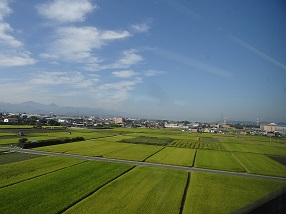
|
The Mikuni Mountain view
 |
|
Mt. Asama

|
Kanazawa Station
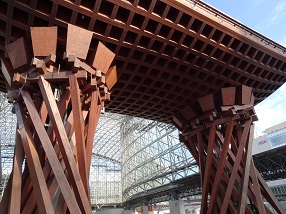 |
|
Hokuriku Shinkansen also connects between the Pacific Ocean side and the Japan Sea side. After passing Karuizawa, Hokuriku Shinkansen runs along the foot of Mt. Asama. You can enjoy the view of Mt. Asama. After leaving Nagano, Hokuriku Shinkansen again runs across a mountain range and comes to the Japan Sea side. The Japan Sea can be seen between Jyostu-Myoko and Kurobe-Unaduki-Onsen. Also, the view of the Tateyama Mountain Range can be seen on your left, when you ravel from Tokyo to Kanazawa. Finally, you will arrive at Kanazawa Station. The fastest "Kagayaki" runs between Tokyo and Kanazawa in a time of two hours and 28 minutes. |
|
The New Luggage Policy, effective on May 20, 2020
|
|||
|
The Overall Dimensions of your Luggage: |
over 250cm | ||
|
You are not allowed to bring the luggage with more than 250cm of the overall dimensions on to a train. This rule has not been chaned and has been effective before May 20, 2020 as well. |
|||
|
The Overall Dimensions of your Luggage: |
between 160cm and 250cm | ||
|
You need to make a seat reservation at the last row of a car. Then, your oversized luggage can be placed at the space between the seats and the wall at the end of the cabin. Please refer the below picture.
Space for your suitcases at the end of the cabin
 |
|||
|
The Overall Dimensions of your Luggage: |
below 160cm | ||
|
JR advises you to put your luggage with less than 160cm of the overall dimensions onto luggage racks above windows.
Luggage Racks above Windows
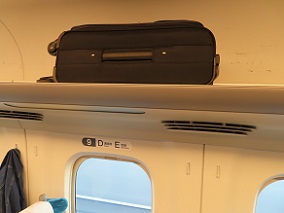 |
|||
|
Note |
*1) The overall dimensions mean the sum of width, depth and hight of the luggage. *2) The policy becomes effective only on the Tokaido, Sanyo and Kyushu Shinkansen Lines operated by JR Central, JR West and JR Kyushu. *3) If you put your luggage at the space between the last row of seats and the entrance door to the car wthout a seat reservation at the last row of seats, your luggage will be installed in a designated room with 1,000 Yen of fee.
Please refer the offcial website of JR Central for the policy: |
||
|
"Back to the Top of Shinkansen"
"Back to the Top Japan Railways Lines"
"Back to the Top of Riding Trains"

Go to the top page of "Historical and Exotic Japan": http://cf916626.cloudfree.jp/HandE_Japan/HandE_Japan.html  Home Page in Japanese: "Shane's HomePage"
Home Page in Japanese: "Shane's HomePage"http://cf916626.cloudfree.jp/index.html 
|